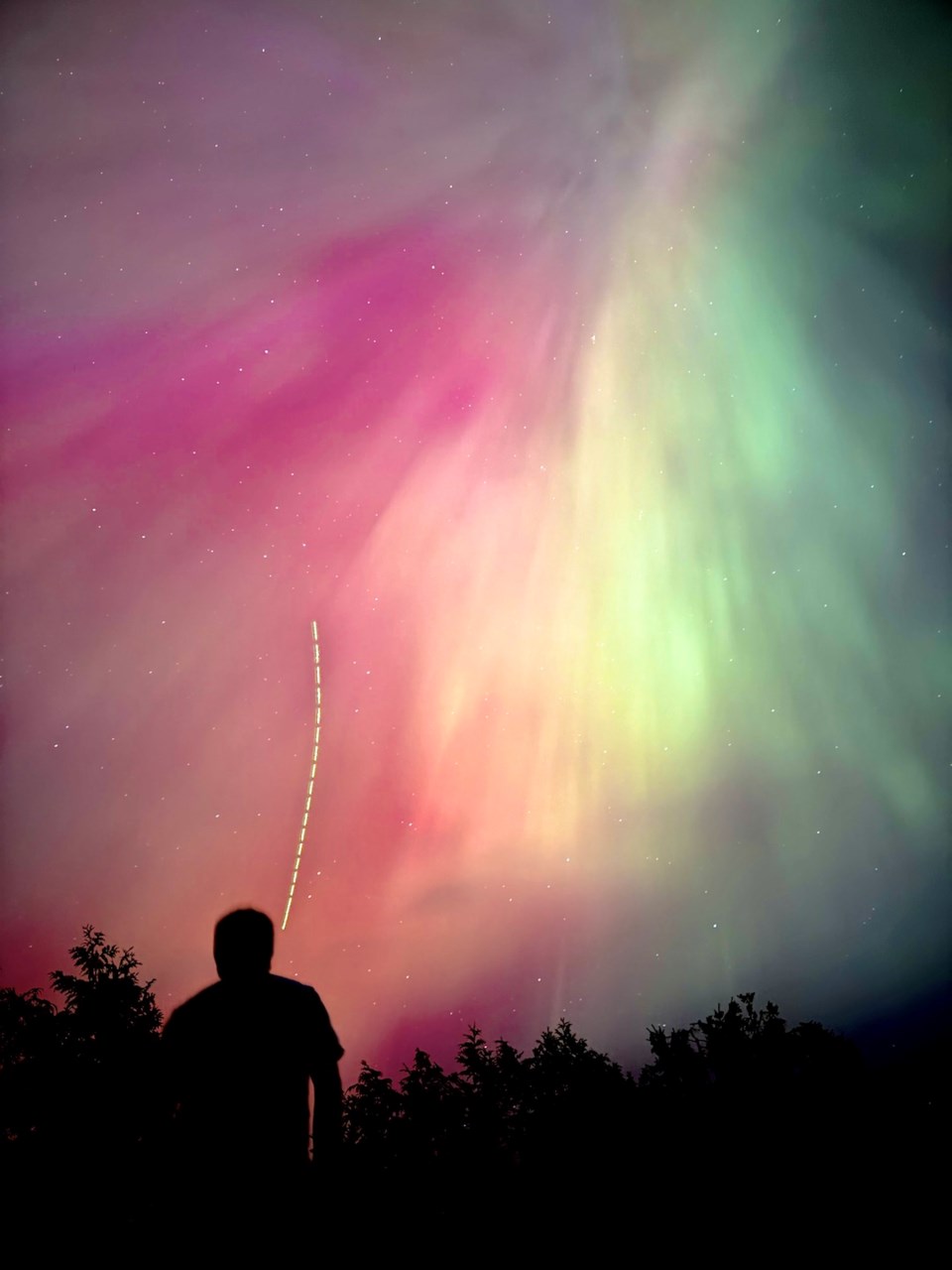The Northern Hemisphere summer solstice this year occurs June 20 at 1:50 p.m. If you remember that the Earth’s rotational axis is tipped about 23.5 degrees from its orbital plane around the sun, the solstice occurs when the projection of the North Pole rotational axis at a right angle onto the orbital plane intersects the sun. That’s when the sun is as far north as it gets in our sky. Yay, summer! But all the planets are over on the other side of the system, close to the sun and the space station passes are over until late June. So, the only other interesting news in the solar system is about the sun itself.
Many on the Sunshine Coast saw the auroras on May 10 and the galleries of images from everything from Astro imaging cameras down to cellphones was impressive. The cause of the whole light show was the impact of part of a coronal mass ejection (CME) from the sun on Earth’s magnetic field. It came from Sunspot 3664, a complex knot of magnetic fields on the sun about 120,000 miles across. According to NASA, a series of six CME’s came from that region and hit the Earth with a glancing blow. We were rather lucky about that because 3664 was pretty much as big as the one that caused the Carrington Event on September 1 and 2, 1859. And, apparently Sunspot 3664 is about to rotate around to our side of the sun again and is still throwing off coronal mass. According to SpaceWeather.com, “Clearly, AR3664 is still active as it turns to face Earth again later this week.”
Let’s hope that any encore performance from 3664 is a miss because the impact of a CME of Carrington size hammers our magnetic field hard and its oscillations cause induced voltages in any conductors exposed to the Earth’s magnetic field. In 1859, auroras were visible in the tropics and telegraph systems erupted in electric arcs (and flames). Some operators continued to use the network with the batteries disconnected for hours. Luckily, no Comm satellites, cell telephone networks, GPS systems, electrical grids, television or radios, computer-controlled vehicles (including aircraft) or domestic water supply systems were affected, mainly because they didn’t exist at that time.
The effects might well be very different were that to occur now, however. A similar, but smaller CME event blacked out Quebec and the NE United States for many hours in 1989 and we are far more reliant upon solid-state integrated circuitry now than we were 35 years ago. A really solid hit from a big CME might well fry a whole lot of equipment and if you think it was rough getting toilet paper during the COVID pandemic, imagine how tough things might be when everyone’s cars, trucks and computers are dead, the power grid has failed and domestic water supplies have to be manually operated, if at all.
On a much less-frightening note, we are likely to see a recurrent nova in our sky sometime this summer. If you look about an hour after sunset for the Big Dipper in the north and follow the “arc” of the handle to a bright star high in the south, that’s Arcturus, a very “handy” name. Then look high in the SE for another bright star – Vega in Lyra. It’s part of the Summer Triangle visible later at night. Almost halfway from Arcturus to Vega, you can pick out a semicircle of fainter stars, which is the constellation Corona Borealis – the Northern Crown. The brightest one is Alphecca, about magnitude 2.2 or so. Just below the bottom of the arc of stars is another named T Corona Borealis, T CrB for short. It’s magnitude 9 or so – way too faint for the naked-eye and probably even for binoculars, at least for me.
What’s interesting about T CrB, though, is that it’s apparently half of a binary system. It’s a star that’s burned through its hydrogen fuel, swelled into a red giant and blown off its outer layers and shrunk down to a bare core of carbon and oxygen known as a white dwarf. It no longer has hydrogen and has shrunk to about the size of Earth, meaning it is still very hot with a ferociously strong surface gravity. Its companion star is now a red giant going through the same process, fusing helium and heavier elements and expanding, cooling and in the same process of blowing off its outer layers. Some of this material gets captured by T CrB and builds up on its surface. It seems to take about 80 years before enough material collects to re-initiate nuclear fusion and all the accumulated hydrogen goes off, fusing into helium, etc. We can expect this explosion to bring the star’s visibility up to about magnitude 2 for a few days before the blaze subsides. The last “nova” occurred in 1864, so we’re apparently due. I gather from some of the articles I’ve read that this cyclical process can continue for quite a while until the white dwarf has accumulated enough new mass that the entire dwarf star is massive enough to blow up in a Type 1A supernova. Happily, it’ll be far enough away to be just a nice lightshow.
Continuing repairs to the Sechelt Library mean the SCAC monthly meeting will be held at the Sechelt Seniors Activity Center at 7 to 9 p.m., Friday June 14. The speaker details will be available on the club website at: sunshinecoastastronomy.wordpress.com.




